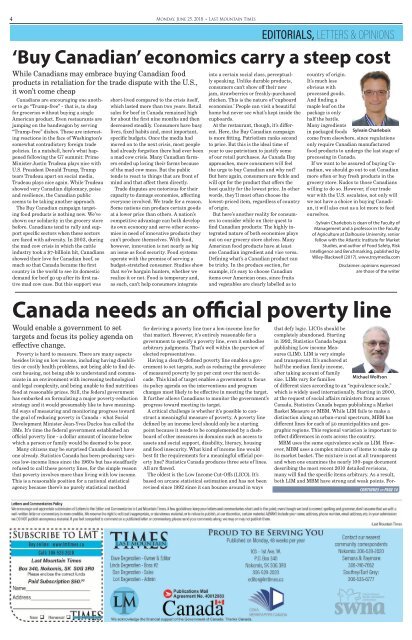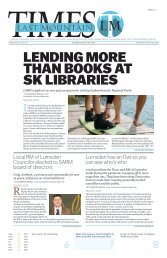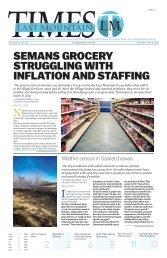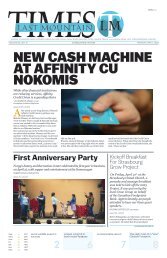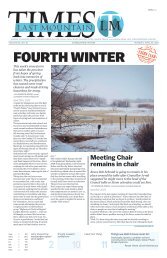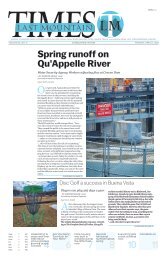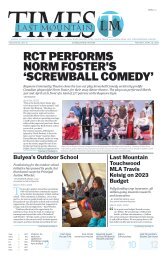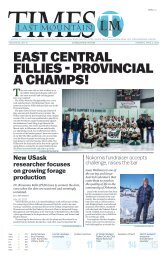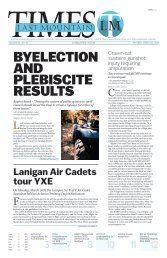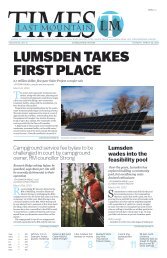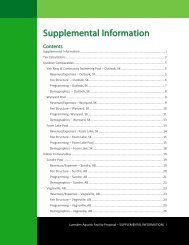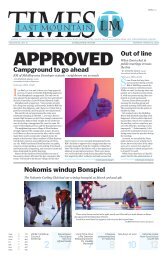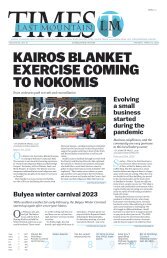LMT_20180625 colour
You also want an ePaper? Increase the reach of your titles
YUMPU automatically turns print PDFs into web optimized ePapers that Google loves.
4 Monday, June 25, 2018 • Last Mountain Times<br />
‘Buy Canadian’ economics carry a steep cost<br />
While Canadians may embrace buying Canadian food<br />
products in retaliation for the trade dispute with the U.S.,<br />
it won’t come cheap<br />
Canadians are encouraging one another<br />
to go “Trump-free” - that is, to shop<br />
for groceries without buying a single<br />
American product. Even restaurants are<br />
jumping on the bandwagon by serving<br />
“Trump-free” dishes. These are interesting<br />
reactions in the face of Washington’s<br />
somewhat contradictory foreign trade<br />
policies. In a nutshell, here’s what happened<br />
following the G7 summit: Prime<br />
Minister Justin Trudeau plays nice with<br />
U.S. President Donald Trump, Trump<br />
tears Trudeau apart on social media,<br />
Trudeau plays nice again. While Trudeau<br />
showed very Canadian diplomacy, poise<br />
and resilience, the Canadian public<br />
seems to be taking another approach.<br />
The Buy Canadian campaign targeting<br />
food products is nothing new. We’ve<br />
shown our solidarity in the grocery store<br />
before. Canadians tend to rally and support<br />
specific sectors when these sectors<br />
are faced with adversity. In 2003, during<br />
the mad cow crisis in which the cattle<br />
industry took a $7-billioin hit, Canadians<br />
showed their love for Canadian beef, so<br />
much so that Canada became the first<br />
country in the world to see its domestic<br />
demand for beef go up after its first native<br />
mad cow case. But this support was<br />
short-lived compared to the crisis itself,<br />
which lasted more than two years. Retail<br />
sales for beef in Canada remained high<br />
for about the first nine months and then<br />
decreased steadily. Consumers have busy<br />
lives, fixed habits and, most important,<br />
specific budgets. Once the media had<br />
moved on to the next crisis, most people<br />
had already forgotten there had ever been<br />
a mad cow crisis. Many Canadian farmers<br />
ended up losing their farms because<br />
of the mad cow mess. But the public<br />
tends to react to things that are front of<br />
mind and that affect them directly.<br />
Trade disputes are notorious for their<br />
capacity to damage economies, affecting<br />
everyone involved. We trade for a reason.<br />
Some nations can produce certain goods<br />
at a lower price than others. A nation’s<br />
competitive advantage can both develop<br />
its own economy and serve other economies<br />
in need of innovative products they<br />
can’t produce themselves. With food,<br />
however, innovation is not nearly as big<br />
an issue as food security. Food systems<br />
operate with the premise of serving a<br />
budget-stretched consumer. Studies show<br />
that we’re bargain hunters, whether we<br />
realize it or not. Food is temporary and,<br />
as such, can’t help consumers integrate<br />
into a certain social class, perceptually<br />
speaking. Unlike durable products,<br />
consumers can’t show off their new<br />
jam, strawberries or freshly-purchased<br />
chicken. This is the nature of ‘cupboard<br />
economics.’ People can visit a beautiful<br />
home but never see what’s kept inside the<br />
cupboards.<br />
At the restaurant, though, it’s different.<br />
Here, the Buy Canadian campaign<br />
is more fitting. Patriotism ranks second<br />
to price. But this is the ideal time of<br />
year to use patriotism to justify some<br />
of our retail purchases. As Canada Day<br />
approaches, more consumers will feel<br />
the urge to buy Canadian and why not?<br />
But here again, consumers are fickle and<br />
will opt for the product that offers the<br />
best quality for the lowest price. In other<br />
words, they’ll most often choose the<br />
lowest-priced item, regardless of country<br />
of origin.<br />
But here’s another reality for consumers<br />
to consider while on their quest to<br />
find Canadian products: The highly integrated<br />
nature of both economies plays<br />
out on our grocery store shelves. Many<br />
American food products have at least<br />
one Canadian ingredient and vice versa.<br />
Defining what’s a Canadian product can<br />
be tricky. In the produce section, for<br />
example, it’s easy to choose Canadian<br />
items over American ones, since fruits<br />
and vegetables are clearly labelled as to<br />
EDITORIALS, LETTERS & OPINIONS<br />
country of origin.<br />
It’s much less<br />
obvious with<br />
processed goods.<br />
And finding a<br />
maple leaf on the<br />
package is only<br />
half the battle.<br />
Many ingredients<br />
in packaged foods Sylvain Charlebois<br />
come from elsewhere, since regulations<br />
only require Canadian manufactured<br />
food products to undergo the last stage of<br />
processing in Canada.<br />
If we want to be assured of buying Canadian,<br />
we should go out to eat Canadian<br />
more often or buy fresh products in the<br />
grocery store. Kudos to those Canadians<br />
willing to do so. However, if our trade<br />
war with the U.S. escalates, not only will<br />
we not have a choice in buying Canadian,<br />
it will also cost us a lot more to feed<br />
ourselves.<br />
-Sylvain Charlebois is dean of the Faculty of<br />
Management and a professor in the Faculty<br />
of Agriculture at Dalhousie University, senior<br />
fellow with the Atlantic Institute for Market<br />
Studies, and author of Food Safety, Risk<br />
Intelligence and Benchmarking, published by<br />
Wiley-Blackwell (2017). www.troymedia.com<br />
Disclaimer: opinions expressed<br />
are those of the writer<br />
Canada needs an official poverty line<br />
Would enable a government to set<br />
targets and focus its policy agenda on<br />
effective change.<br />
Poverty is hard to measure. There are many aspects<br />
besides living on low income, including having disabilities<br />
or costly health problems, not being able to find decent<br />
housing, not being able to understand and communicate<br />
in an environment with increasing technological<br />
and legal complexity, and being unable to find nutritious<br />
food at reasonable prices. Still, the federal government<br />
has embarked on formulating a major poverty-reduction<br />
strategy and it would presumably like to have meaningful<br />
ways of measuring and monitoring progress toward<br />
the goal of reducing poverty in Canada - what Social<br />
Development Minister Jean-Yves Duclos has called the<br />
3Ms. It’s time the federal government established an<br />
official poverty line - a dollar amount of income below<br />
which a person or family would be deemed to be poor.<br />
Many citizens may be surprised Canada doesn’t have<br />
one already. Statistics Canada has been producing various<br />
low-income lines since the 1960s but has steadfastly<br />
refused to call these poverty lines, for the simple reason<br />
that poverty involves more than living with low income.<br />
This is a reasonable position for a national statistical<br />
agency because there’s no purely statistical method<br />
for deriving a poverty line (nor a low-income line for<br />
that matter). However, it’s entirely reasonable for a<br />
government to specify a poverty line, even it embodies<br />
arbitrary judgments. That’s well within the purview of<br />
elected representatives.<br />
Having a clearly-defined poverty line enables a government<br />
to set targets, such as reducing the prevalence<br />
of measured poverty by 50 per cent over the next decade.<br />
This kind of target enables a government to focus<br />
its policy agenda on the interventions and program<br />
changes most likely to be effective in meeting the target.<br />
It further allows Canadians to monitor the government’s<br />
progress toward meeting its target.<br />
A critical challenge is whether it’s possible to construct<br />
a meaningful measure of poverty. A poverty line<br />
defined by an income level should only be a starting<br />
point because it needs to be complemented by a dashboard<br />
of other measures in domains such as access to<br />
assets and social support, disability, literacy, housing<br />
and food insecurity. What kind of income line would<br />
best fit the requirements for a meaningful official poverty<br />
line? Statistics Canada produces three sets of lines.<br />
All are flawed.<br />
The oldest is the Low Income Cut-Offs (LICO). It’s<br />
based on arcane statistical estimation and has not been<br />
revised since 1992 since it can bounce around in ways<br />
that defy logic. LICOs should be<br />
completely abandoned. Starting<br />
in 1992, Statistics Canada began<br />
publishing Low income Measures<br />
(LIM). LIM is very simple<br />
and transparent. It’s anchored at<br />
half the median family income,<br />
after taking account of family<br />
Michael Wolfson<br />
size. LIMs vary for families<br />
of different sizes according to an “equivalence scale,”<br />
which is widely used internationally. Starting in 2000,<br />
at the request of social affairs ministers from across<br />
Canada, Statistics Canada began publishing a Market<br />
Basket Measure or MBM. While LIM fails to make a<br />
distinction along an urban-rural spectrum, MBM has<br />
different lines for each of 50 municipalities and geographic<br />
regions. This regional variation is important to<br />
reflect differences in costs across the country.<br />
MBM uses the same equivalence scale as LIM. However,<br />
MBM uses a complex mixture of items to make up<br />
its market basket. The mixture is not at all transparent<br />
and when one examines the nearly 100-page document<br />
describing the most recent 2010 detailed revisions,<br />
many will find the specific items arbitrary. As a result,<br />
both LIM and MBM have strong and weak points. For-<br />
CONTINUES on PAGE 14


